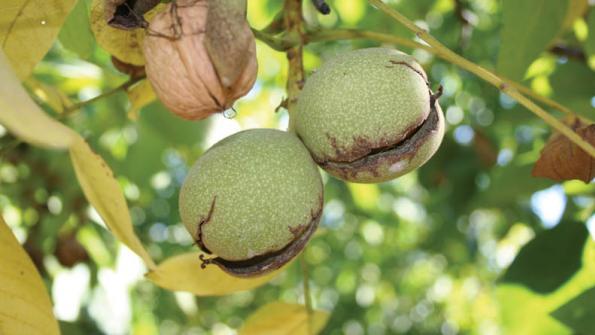August 3, 2016

A walnut grower who reduces efforts to deliver a well-dried, clean product that’s free of insect injury, mold, and shriveled, discolored, or otherwise damaged meats to the handler can leave a sizable amount of money on the table when the crop is sold.
This message has been shared with walnut growers over the last several years by industry consultant Pete Turner of Turner and Associates, Stockton, Calif., and chairman of the California Walnut Handler Coalition.
Factors which influence walnut prices are: 1 - grade, whether U.S. No. 1, U.S. Commercial or Unclassified; 2 - size, including halves, halves and pieces, or small pieces; and 3 - color, ranging from extra light or light to the darker amber or the darkest color – off color.
“If you only have darker than light or amber material to offer, the packer will have a tougher time marketing the walnut which can lower payments back to the grower,” Turner says.
At one time, Turner says the industry’s rule of thumb was to price Combos (at least 60 percent light-colored kernels in a given lot) about 10-15 cents per pound less than Lights (at least 80 percent light kernels in a lot).
A few years ago the difference increased to about 60-70 cents a pound. By early July of this year, the spread in the price between Lights and Combos had widened to around $1.10 to $1.30 per pound, Turner reports.
“This reflects the increasing demand by buyers overseas for light-colored material,” Turner says. “In fact, very few export markets will even buy Combos.”
About two-thirds of the walnuts grown in California are sold overseas, he adds.
Rick Buchner, University of California Cooperative Extension farm advisor for Tehama, Glenn and Butte counties, describes in the July 2016 issue of the University of California Cooperative Extension newsletter Orchard Facts that getting top price for a walnut crop is a season-long job.
It includes managing the crop’s need for water and fertilizers, disease and pest control, and minimizing sunburn damage.
Buchner offers these tips to control crop quality between now and the day the crop is delivered to the handler.
1 - Prevent or minimize damage to the hull as the crop matures - Typically, the green husk provides a degree of protection for the shell and kernel. However, high humidity combined with high temperatures can cause the growth of kernel-damaging mold spores.
In addition, proper irrigation can also help by encouraging shoot and leaf growth to help protect the crop from hot, dry weather. These conditions can cause hulls to shrivel around the shell, providing an ideal place for mold to grow and infect the kernel.
Walnut husk fly maggots feeding inside the husk can lower nut quality by causing the fleshy parts of the husks to decay, staining the nut shell, and rendering it unmarketable for in-shell sale. Walnut husk fly damage can provide a foothold for mold to infest the nut.
2 - Harvest as close to hull split as possible - Harvesting walnuts near the beginning of hull split increases the percentage of light-colored kernels and decreases the incidence of insect and mold damage.
However, in the Sacramento Valley, the quality of walnut kernels peaks several weeks before hull split, says Buchner.
“That’s when the packing tissue around the kernel halves just turns brown (packing tissue brown or PTB) and the kernels are lightest in color and of highest quality,” Buchner says. “Unfortunately, that’s before adequate hull split allows for good commercial crop removal.”
Removing at least 80 percent of the nuts on a tree, of which 95 percent of the hulls can be removed, is considered an economic harvest, he explains.
One way to better balance the quality-economic equation is to treat the crop with ethephon (Ethrel), a synthetic version of the plant growth regulator ethylene, to accelerate hull split. This can promote an early or once-over harvest, says Buchner.
However, he advises against applying ethephon to stressed trees.
“Many walnut growers use ethephon successfully to manipulate harvest timing,” he says. “One approach, which removes about 90 percent of the nuts, involves applying ethephon at 100 percent PTB. This promotes harvest about 14 to 23 days after application, which would be about 7 to 10 days ahead of a normal harvest.”
Buchner says ethephon can also be applied about 10 days prior to the normal harvest date. This can increase the proportion of harvested nuts and hull removal so that a second harvest is usually not economical.
“Good results with ethephon require experience,” he notes.
More information is available on the UCCE website.
In some cases, a two-shake harvest can offer an economical alternative to ethephon treatments, Buchner says.
“The first shake will harvest the high quality early nuts and a second shake 7 to 10 days later will get the remaining crop,” he explains. “Not everyone has the equipment or harvest plan that allows for a two-shake harvest. Individual growers need to decide if the higher quality equals or exceeds the cost of the second shake.”
3 - Once harvest begins, pick up, hull, and dry nuts as soon as possible - Most loss of quality occurs during the first nine hours after shaking, he says. This is particularly true if air temperatures are high at harvest, or nuts are in direct sunlight. Walnuts left on the damp ground are more susceptible to mold damage.
4 - Dry nuts quickly after pick-up to help further reduce kernel mold
More tips on maximizing walnut quality are available in Buchner’s article in the July 2016 Orchard Facts newsletter.
You May Also Like




